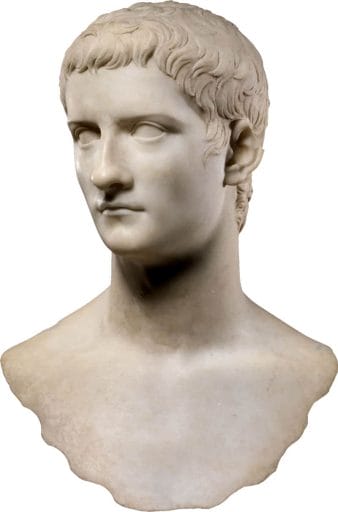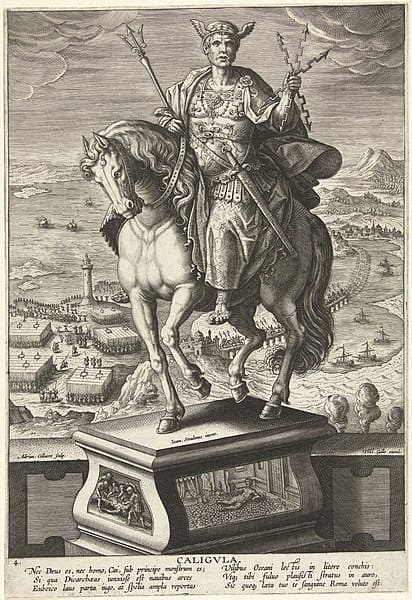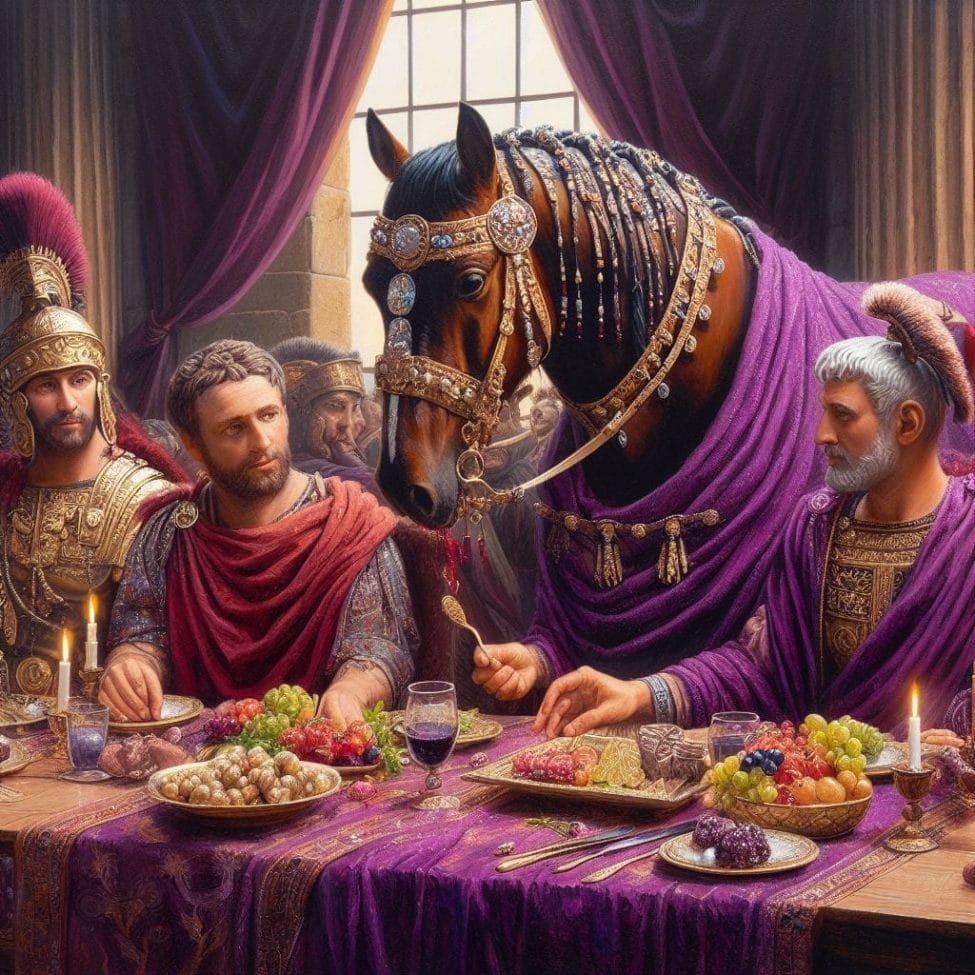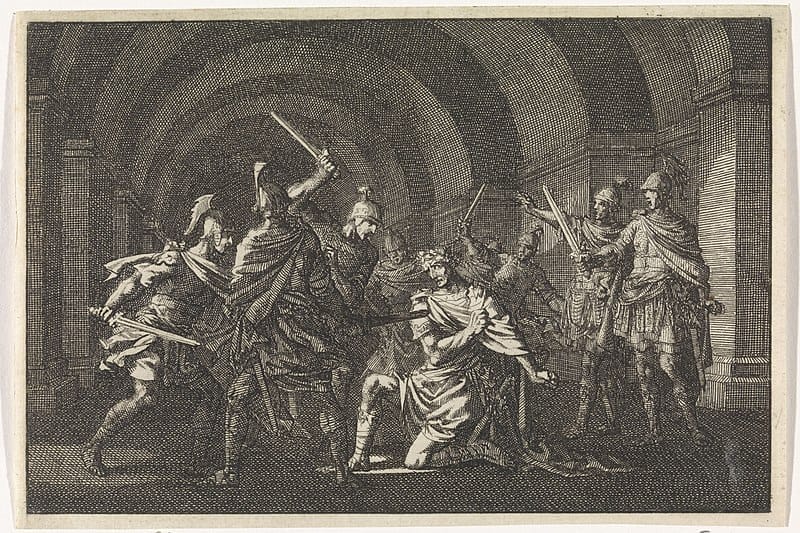Last Updated on October 24, 2023 by Vladimir Vulic
Life: AD 12 – 41

- Name: Gaius Caesar Augustus Germanicus
- Born in AD 12
- Son of Germanicus Caesar (15 BC-AD 19), nephew of Tiberius, and Agrippina (14 BC-AD 33), granddaughter of Augustus.
- Became emperor in AD 37.
- Married (1) Junia Claudilla; (2) Livia Orestilla; (3) Lollia Paulina; (4) Caesonia (one daughter, Julia).
- Assassinated on 24 January AD 41.
Introduction: The Enigmatic Emperor Caligula
Gaius Julius Caesar Germanicus was the third son of Germanicus (nephew of Tiberius) and Agrippina the elder and was born at Antium in AD 12.
Origin of the Name ‘Caligula’
It was during his stay with his parents on the German frontier, when he was between two and four, that his miniature versions of military sandals (caligae), caused the soldiers to call him Caligula, ‘little sandal’. It was a nickname which remained with him for the rest of his life.
Tragedies in Caligula’s Youth
When he was in his late teens, his mother and elder brothers were arrested and died horribly due to the plotting of the praetorian prefect Sejanus. Without a doubt, the horrendous demise of his closest relatives must have had a profound effect on the young Caligula.
Surviving Sejanus’ Schemes
Attempting to rid himself of Gaius, Sejanus, under the belief that he may be a potential successor, went too far and was arrested and put to death by orders of emperor Tiberius in AD 31. In the same year, Caligula was invested as a priest.
From AD 32 onwards, he lived on the island of Capreae (Capri) in the emperor’s lush residence and was appointed joint heir with Tiberius Gemellus, son of Drusus the younger. Though by that time, Tiberius was in old age and, with Gemellus still a child, it was obvious that it would be Caligula who would truly inherit the power for himself. By AD 33, he was made quaestor, though he was given no further administrative training at all.
The Story Behind His Crowning as an Emperor
Caligula was very tall, with spindly legs and a thin neck. His eyes and temples were sunken, and his forehead broad and glowering. His hair was thin, and he was bald on top, though he had a hairy body (during his reign, it was a crime punishable by death to look down on him as he passed by or to mention a goat in his presence). There were rumors surrounding the death of Tiberius. It is very likely that the 77-year-old emperor did simply die of old age.
But one account tells of how Tiberius was thought to have died. Caligula drew the imperial signet ring from his finger and was greeted as emperor by the crowd. Then, however, news reached the would-be emperor that Tiberius had recovered and was requesting food be brought to him. Caligula terrified at any revenge by the emperor returned from the dead, froze on the spot. But Naevius Cordus Sertorius Macro, commander of the praetorians, rushed inside and smothered Tiberius with a cushion, suffocating him.
In any case, with the support of Macro, Caligula was immediately hailed as princeps (‘first citizen’) by the senate (AD 37). No sooner did he get back to Rome than the senate bestowed upon him all the powers of the imperial office, and – declaring Tiberius’ will invalid – the child Gemellus was not granted his claim to the joint reign. But it was above all the army which, very loyal to the house of Germanicus, sought to see Caligula as sole ruler.
Pragmatic Ruling of Caligula
Caligula quietly dropped an initial request for the deification of the deeply unpopular Tiberius. All around, there was much rejoicing at the investment of a new emperor after the dark later years of his predecessor. He abolished Tiberius’ gruesome treason trials, paid generous bequests to the people of Rome, and an especially handsome bonus to the praetorian guard.
There is an amusing anecdote surrounding Caligula’s accession to the throne. For he had a pontoon bridge built leading across the sea from Baiae to Puzzuoli; a stretch of water two and a half miles long. The bridge was even covered with earth. With the bridge in place, Caligula, in the attire of a Thracian gladiator, mounted a horse and rode across it. Once at one end, he got off his horse and returned on a chariot drawn by two horses. These crossings are said to have lasted for two days.

The historian Suetonius explains that this bizarre behavior was down to a prediction made by an astrologer called Trasyllus to emperor Tiberius, that ‘Caligula had no more chance of becoming emperor than of crossing the bay of Baiae on horseback’.
Then, only six months later (October AD 37), Caligula fell very ill. His popularity was such that his illness caused great concern throughout the entire empire. But, when he recovered, he was no longer the same man. Rome soon found itself living in a nightmare.
Becoming an Unbalanced Leader
According to the historian Suetonius, Caligula has since childhood suffered from epilepsy, known in Roman times as the ‘parliamentary disease.’ Since it was regarded as an especially bad omen if anyone had a fit while public business was being conducted – his very distant cousin, Julius Caesar, also suffered occasional attacks. This, or some other cause, violently affected his mental state, and he became totally irrational, with delusions not only of grandeur but also of divinity.
He now suffered from a chronic inability to sleep, managing only a few hours of sleep a night and then suffering from horrendous nightmares. Often, he would wander through the palace waiting for daylight. Caligula had four wives, three of them during his reign as emperor, and he was said to have committed incest with each of his three sisters in turn.
In AD 38, Caligula put to death without trial his principal supporter, the praetorian prefect Macro. The young Tiberius Gemellus suffered the same fate. Marcus Junius Silanus, the father of the first of Caligula’s wives, was compelled to commit suicide.
Caligula became ever more unbalanced. Seeing the emperor ordering an altar to be built for himself was worrying to Romans. But to propose that statues of himself should be erected in synagogues was more than merely worrying. His excesses knew no bounds, and he introduced heavy taxation to help pay for his personal expenditure. He also created a new tax on prostitutes and is said to have opened a brothel in a wing of the imperial palace.
All these occurrences naturally alarmed the Senate. By now, there was no doubt that the emperor of the civilized world was, in fact, a dangerous madman. Confirming their worst fears, in AD 39, Caligula announced the revival of the treason trials, the bloodthirsty trials which had given an air of terror to the latter years of Tiberius’ reign.
The ‘Consul’ Incitatus
Caligula also kept his favorite racehorse, Incitatus, inside the palace in a stable box of carved ivory, dressed in purple blankets and collars of precious stones. Dinner guests were invited to the palace in the horse’s name. And the horse, too, was invited to dine with the emperor. He was even said to have considered making the horse consul. Rumors of disloyalty began to reach an ever more deranged emperor. In light of this, a recently retired governor of Pannonia was ordered to commit suicide.

Then Caligula considered plans to revive the expansionist campaigns of his father, Germanicus, across the Rhine. But before he left Rome, he learned that the army commander of Upper Germany, Cnaeus Cornelius Lentulus Gaetulicus, was conspiring to have him assassinated.
The Conquest of Germany
In spite of this, Caligula, in September AD 39, set out for Germany, accompanied by a strong detachment of the praetorian guard and his sisters Julia Agrippina, Julia Livilla, and Marcus Aemilius Lepidus (widower of Caligula’s dead sister Julia Drusilla). Soon after he had arrived in Germany, not only Gaetulicus but also Lepidus was put to death. Julia Agrippina and Julia Livilla were banished, and their property was seized by the emperor.
The following winter, Caligula spent along the Rhine and in Gaul. Neither his planned German campaign nor a proposed military expedition to Britain ever took place. Though there are reports of his soldiers being ordered to gather shells on the shore as trophies for Caligula’s ‘conquest of the sea’.
Meanwhile, a senate granted him all kinds of honors for his imaginary victories. It comes as no surprise then that at least three further conspiracies were soon launched against Caligula’s life. Were some foiled, then one succeeded. Caligula’s suspicion that his joint praetorian prefects, Marcus Arrecinus Clemens, and his unknown colleague, were planning his assassination prompted them, in order to avoid their execution, to join a part of senators in a plot. The conspirators found a willing assassin in the praetorian officer Cassius Chaerea, whom Caligula had openly mocked at court for his effeminacy.
Conclusion: The End of a Tyrant’s Reign
On 24 January AD, 41 Cassius Chaerea, together with two military colleagues, fell upon the emperor in a corridor of his palace. Some of his German personal guards rushed to his aid but came too late. Several praetorians then swept through the palace, seeking to kill any surviving relatives. Caligula’s fourth wife, Caesonia, was stabbed to death, and her baby daughter’s skull was smashed against a wall.

The scene was truly a gruesome one, but it freed Rome from the insane rule of a tyrant.
Caligula had been emperor for less than four years.
People Also Ask:
What is Caligula best known for?
Gaius Caesar Augustus Germanicus, better known as Caligula, was the third emperor of the Roman Empire and a member of the Julio-Claudian dynasty. His reign was short, only lasting from 37 CE to 41 CE. Today, he is well known for his cruel behavior and possible insanity.
Why was Caligula called the Mad King?
There are few surviving sources about the reign of Caligula, though he is described as a noble and moderate emperor during the first six months of his rule. After this, the sources focus on his cruelty, sadism, extravagance, and sexual perversion, presenting him as an insane tyrant.
What was Caligula’s illness?
It is plausible that Caligula experienced epilepsy that began in childhood, possibly with febrile seizures and later dialeptic or cognitive seizures. Caligula later experienced status epilepticus in 37 CE, which triggered an epileptic psychosis with the consequent psychopathic and paranoid changes.
What happened to Caligula after he died?
In 41 AD, four months after he returned from Gaul, he was murdered by his closest advisors, including members of his Praetorian Guard. To prevent reprisals, they also killed his wife and daughter. Dead but certainly not mourned, Caligula was succeeded by his uncle, Claudius, the most unlikely of emperors.

Historian Franco Cavazzi dedicated hundreds of hours of his life to creating this website, roman-empire.net as a trove of educational material on this fascinating period of history. His work has been cited in a number of textbooks on the Roman Empire and mentioned on numerous publications such as the New York Times, PBS, The Guardian, and many more.
